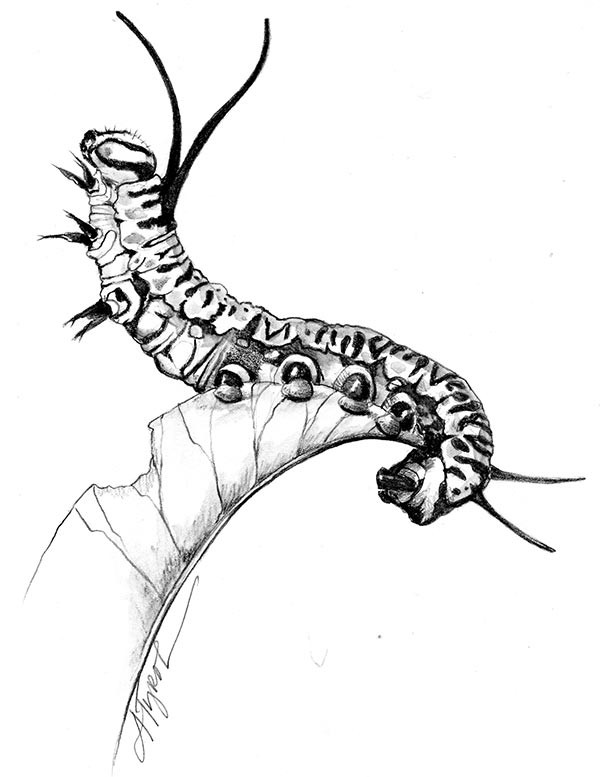
Earlier this summer, my daughter persuaded me to bring home a monarch egg. I had misgivings. This wasn’t my first butterfly rodeo, and previous experience was discouraging. Two summers past, a friend gave us several black swallowtail caterpillars. One lived to adulthood, but all the siblings wasted away, taking on the form of burnt bacon gristle.
On the plus side, this time we’d be starting with an egg, and a new one at that. We had found it minutes after watching the mother butterfly flutter down into a milkweed patch.
A new egg, I reckoned, was safer. In practical parental terms: if we raised the caterpillar in a reasonably sterile environment, it seemed unlikely to die in spectacularly horrid fashion, for example, by bursting open to reveal tachnid fly larvae, and thus inspiring tears and difficult religious conversations during the morning drive to daycare.
So I agreed to take it home. I begged my children not to get emotionally attached. I emphasized that we were starting a science project, not adopting a pet.
Over the next five days we watched as the egg elongated, and its radial grooves, running base to tip, became more distinct. By the fifth day, the top of the egg had darkened, and soon after a tiny, translucent maggot with a black head popped out. The kids named it Hatchy Tractor Tillinghast. “Hatchy” for obvious reasons; “Tractor” because my son, age four, is of the firm opinion that anything is better with a tractor in the middle of it.
Hatchy’s first order of business was to devour its own egg case. This is standard operating procedure for many caterpillars, and provides them with a protein-rich first meal. Our young monarch’s next act (after resting) involved weird back and forth swaying – what my kids described as its “waggle dance.” By the end of its first day, it had chewed a hole through the middle of the leaf, and turned light green.
Given my anxieties about the impact of caterpillar death on family serenity, it’s just as well that I was ignorant about monarch feeding behaviors. Although monarch lives are fraught with peril at every stage – from egg-eating ants to any number of dangers during the fall migration down to Mexico – it turns out that one of the most dangerous moments of all is the caterpillar’s first vegetarian meal.
In his excellent new book, Monarchs and Milkweed, Cornell professor Anurag Agrawal described the evolutionary arms race between monarch butterflies and their host plant. For many milkweed species (including our common milkweed, Asclepias syriaca) the first line of defense is the plant’s woolly texture. A thick forest of hairs creates a wall between caterpillars and the leaf surface. In retrospect, I believe Hatchy’s swaying behavior was an effort to get through this barrier – what Agrawal described as “mowing the lawn.” A young monarch caterpillar spends precious energy shaving off leaf hairs in order to clear a feeding patch.
Next comes the dangerous moment, the first bite. According to research cited by Agrawal, odds are remarkably grim, with more than 60 percent of monarch caterpillars dying from their first leaf meal. The killer is latex – the milky fluid from which milkweed gets its name. This fast drying goo, stored under pressure and released when a leaf is injured, can swamp a young caterpillar and seal its mouth shut. Toxins in the latex can also be lethal.
In retrospect, I suspect that we improved our caterpillar’s chances by providing cut leaves with some of the latex already draining out of the stems. Hatchy also appeared to follow a typical irrigation tactic to reduce latex exposure. The middle leaf holes, which it made as a young caterpillar, were likely examples of “circle trench” feeding. This involves biting holes in a circular pattern, and retracting the head every time that the latex wells up. When the circle’s complete, the caterpillar has created an island of leaf tissue that’s relatively latex-free.
There was never a time that I stopped dreading caterpillar catastrophe, especially as Hatchy grew bigger and cuter, and my daughter began reading it evening bedtime stories. (Hatchy, she reported, did not like books with pictures of birds.) But the caterpillar continued to thrive, progressing rapidly through its five instars; at each molt, it efficiently popped off its head and wriggled out of its old skin, eating both. When Hatchy did eventually split open, what emerged was not a parasitic fly but a perfect green chrysalis. Eleven days later, a male monarch butterfly emerged, its gender evident from the black spots on its hind wings.
Its wings dried. We let it go. It fluttered high into a maple tree, and for a while at least, lived.


Discussion *